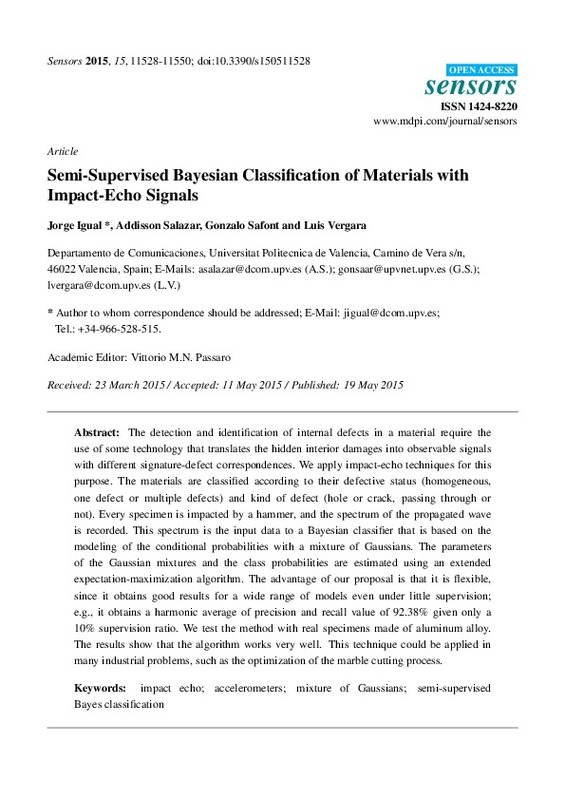JavaScript is disabled for your browser. Some features of this site may not work without it.
Buscar en RiuNet
Listar
Mi cuenta
Estadísticas
Ayuda RiuNet
Admin. UPV
Semi-supervised bayesian classification of materials with impact-echo signals
Mostrar el registro sencillo del ítem
Ficheros en el ítem
| dc.contributor.author | Igual García, Jorge
|
es_ES |
| dc.contributor.author | Salazar Afanador, Addisson
|
es_ES |
| dc.contributor.author | Safont Armero, Gonzalo
|
es_ES |
| dc.contributor.author | Vergara Domínguez, Luís
|
es_ES |
| dc.date.accessioned | 2016-07-14T12:04:22Z | |
| dc.date.available | 2016-07-14T12:04:22Z | |
| dc.date.issued | 2015-05 | |
| dc.identifier.issn | 1424-8220 | |
| dc.identifier.uri | http://hdl.handle.net/10251/67602 | |
| dc.description.abstract | [EN] The detection and identification of internal defects in a material require the use of some technology that translates the hidden interior damages into observable signals with different signature-defect correspondences. We apply impact-echo techniques for this purpose. The materials are classified according to their defective status (homogeneous, one defect or multiple defects) and kind of defect (hole or crack, passing through or not). Every specimen is impacted by a hammer, and the spectrum of the propagated wave is recorded. This spectrum is the input data to a Bayesian classifier that is based on the modeling of the conditional probabilities with a mixture of Gaussians. The parameters of the Gaussian mixtures and the class probabilities are estimated using an extended expectation-maximization algorithm. The advantage of our proposal is that it is flexible, since it obtains good results for a wide range of models even under little supervision; e.g., it obtains a harmonic average of precision and recall value of 92.38% given only a 10% supervision ratio. We test the method with real specimens made of aluminum alloy. The results show that the algorithm works very well. This technique could be applied in many industrial problems, such as the optimization of the marble cutting process. | es_ES |
| dc.description.sponsorship | This work has been supported by Generalitat Valenciana under Grants PROMETEO II/2014/032, ISIC/2012/006 and GV/2014/034. | |
| dc.language | Inglés | es_ES |
| dc.publisher | MDPI | es_ES |
| dc.relation.ispartof | Sensors | es_ES |
| dc.rights | Reconocimiento (by) | es_ES |
| dc.subject | Impact echo | es_ES |
| dc.subject | Accelerometers | es_ES |
| dc.subject | Mixture of Gaussians | es_ES |
| dc.subject | Semi-supervised | es_ES |
| dc.subject | Bayes classification | |
| dc.subject.classification | TEORIA DE LA SEÑAL Y COMUNICACIONES | es_ES |
| dc.title | Semi-supervised bayesian classification of materials with impact-echo signals | es_ES |
| dc.type | Artículo | es_ES |
| dc.identifier.doi | 10.3390/s150511528 | |
| dc.relation.projectID | info:eu-repo/grantAgreement/GVA//PROMETEOII%2F2014%2F032/ES/TÉCNICAS AVANZADAS DE FUSIÓN EN TRATAMIENTO DE SEÑALES/ | es_ES |
| dc.relation.projectID | info:eu-repo/grantAgreement/GVA//ISIC%2F2012%2F006/ | es_ES |
| dc.relation.projectID | info:eu-repo/grantAgreement/GVA//GV%2F2014%2F034/ | es_ES |
| dc.rights.accessRights | Abierto | es_ES |
| dc.contributor.affiliation | Universitat Politècnica de València. Departamento de Comunicaciones - Departament de Comunicacions | es_ES |
| dc.contributor.affiliation | Universitat Politècnica de València. Instituto Universitario de Telecomunicación y Aplicaciones Multimedia - Institut Universitari de Telecomunicacions i Aplicacions Multimèdia | es_ES |
| dc.description.bibliographicCitation | Igual García, J.; Salazar Afanador, A.; Safont Armero, G.; Vergara Domínguez, L. (2015). Semi-supervised bayesian classification of materials with impact-echo signals. Sensors. 15(5):11528-11550. https://doi.org/10.3390/s150511528 | es_ES |
| dc.description.accrualMethod | S | es_ES |
| dc.relation.publisherversion | http://dx.doi.org/10.3390/s150511528 | es_ES |
| dc.description.upvformatpinicio | 11528 | es_ES |
| dc.description.upvformatpfin | 11550 | es_ES |
| dc.type.version | info:eu-repo/semantics/publishedVersion | es_ES |
| dc.description.volume | 15 | es_ES |
| dc.description.issue | 5 | es_ES |
| dc.relation.senia | 298056 | es_ES |
| dc.identifier.pmid | 25996512 | en_EN |
| dc.identifier.pmcid | PMC4481956 | en_EN |
| dc.contributor.funder | Generalitat Valenciana |








